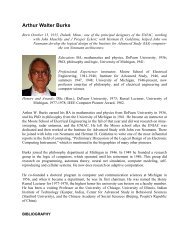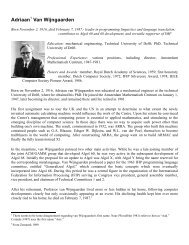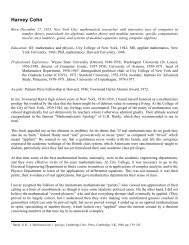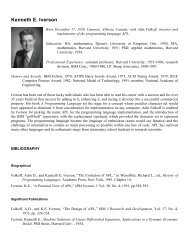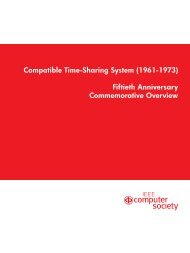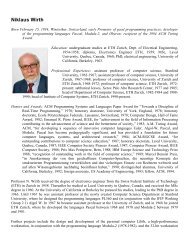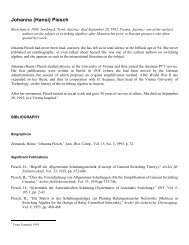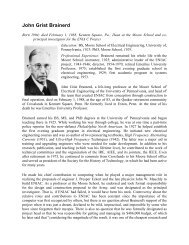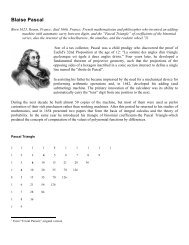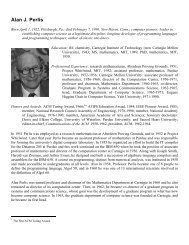230 TUGboat, Volume 32 (2011), No. 2 An appreciation: The Art of ...
230 TUGboat, Volume 32 (2011), No. 2 An appreciation: The Art of ...
230 TUGboat, Volume 32 (2011), No. 2 An appreciation: The Art of ...
Create successful ePaper yourself
Turn your PDF publications into a flip-book with our unique Google optimized e-Paper software.
<strong>230</strong> <strong>TUGboat</strong>, <strong>Volume</strong> <strong>32</strong> (<strong>2011</strong>), <strong>No</strong>. 2ters have been covered in depth by other books<strong>An</strong> <strong>appreciation</strong>: <strong>The</strong> <strong>Art</strong> <strong>of</strong> Computer1 CSLI Publications, Stanford, CA, 1999 2 http://en.wikipedia.org/wiki/Bill_GosperProgramming, <strong>Volume</strong> 4ADavid Waldenand as the topics covered by some <strong>of</strong> the chaptersexpanded dramatically (perhaps partially as a result<strong>of</strong> Knuth’s example <strong>of</strong> rigorous, comprehensiveDonald E. Knuth, <strong>The</strong> <strong>Art</strong> <strong>of</strong> Computerbooks describing computer algorithms). To-Programming, <strong>Volume</strong> 4A: CombinatorialAlgorithms, Part 1. Addison-Wesley, Boston.day Knuth hopes to produce five volumes, <strong>of</strong> whichthe current volume 4 will have at least three partsJan. <strong>2011</strong>. 912 pp. Hardcover, US$74.99. (books): http://www-cs-faculty.stanford.edu/ISBN 0-201-03804-8.~uno/taocp.htmlA book <strong>of</strong> algorithms relating to computer programmingand their analysis (and about problemPart 1 (that is, book 1) <strong>of</strong> <strong>Volume</strong> 4 (the overallvolume is on combinatorial algorithms) covers ansolving more generally) would not normally be reviewedin this journal about typesetting and fonts.Introduction, Zeros and Ones (with four subsections)and Generating All Possibilities (with one subsectioncontaining seven subsubsections). Curiously,However, TEX, TUG, and <strong>TUGboat</strong> would not existwithout the problem Knuth faced in 1976 with thethe second and third subsections on Generating Allthe typesetting <strong>of</strong> the second edition <strong>of</strong> <strong>Volume</strong> 2 <strong>of</strong>Possibilities are not due until <strong>Volume</strong> 4B. Perhaps<strong>The</strong> <strong>Art</strong> <strong>of</strong> Computer Programming (TAOCP); andat 912 pages (and after publication <strong>of</strong> the groupsthus TAOCP is a key part <strong>of</strong> the history <strong>of</strong> the TEX<strong>of</strong> pages from the book over the past half dozen orworld. Many readers <strong>of</strong> this journal already knowmore years as a succession <strong>of</strong> five fascicles), Knuth orthis story (told in chapter 1 <strong>of</strong> Knuth’s book Digitalthe publisher decided that <strong>Volume</strong> 4A was alreadyTypography). 1 Addison-Wesley had gotten rid itslong enough.Monotype technology in 1963 and could not reproducewith the photo-optical machines <strong>of</strong> the timeAs with the previous volumes <strong>of</strong> TAOCP, thisbook is substantially about the analysis <strong>of</strong> the algorithmspresented and not just a cookbook <strong>of</strong> algo-the high quality typesetting <strong>of</strong> the original printings<strong>Volume</strong>s 1–3 (and new printings <strong>of</strong> <strong>Volume</strong>s 1 and 3rithms. A reader can either just find what Knuthdone with Monotype machines still found in Europe).says is the best method and use it, or can learn whyConsequently, in 1977 Knuth began developing ait is a good method, why other methods are not sonew typesetting system to restore the high qualitygood, and how to do the math to analyze the performance<strong>of</strong> one’s own situations where the algorithmstypesetting <strong>of</strong> books, in particular TAOCP. EventuallyTEX was available and became popular withmight be used. <strong>The</strong> book also includes Knuth’s usualvarious groups <strong>of</strong> users; and the TEX Users Groupsets <strong>of</strong> exercises and hundreds <strong>of</strong> pages <strong>of</strong> answers toand <strong>TUGboat</strong> came into being.exercises.Of the parts <strong>of</strong> <strong>Volume</strong> 4A I have touched onI bought <strong>Volume</strong>s 1, 2, and 3 <strong>of</strong> this series immediatelyafter publication <strong>of</strong> each book in 1968, 1969, Greek squares (the clearest I have ever read), and Iso far, I greatly enjoyed the discussion <strong>of</strong> Latin andand 1973 and used them frequently in my pr<strong>of</strong>ession know I am going to enjoy reading more <strong>of</strong> the discussionon bitwise tricks and techniques, a topic thatas a computer programmer. I also bought new editions<strong>of</strong> these books as they came out over the years, has always fascinated me. I also have looked at somekeeping my complete set <strong>of</strong> TAOCP up to date. Thus, <strong>of</strong> the resources on Knuth’s web site augmenting discussionsin the book (and the reader’s own use <strong>of</strong> theto maintain my complete set <strong>of</strong> TAOCP, I bought<strong>Volume</strong> 4A immediately upon its publication and methods Knuth describes and analyzes). I also enjoyhave been dipping into it to get an overall sense <strong>of</strong> skimming pages <strong>of</strong> Knuth’s TAOCP, skipping the realit. (As I suspect is the case with many other readers math and reading bits <strong>of</strong> math-and-algorithm history.<strong>of</strong> this series, I have never read a volume completely Section 7.2.1.7, History and further references, looksthrough, but rather skimmed each book enough to like it will be particularly fun reading. I never tryknow what was in it and then studied particular to work any TAOCP exercises but rather will dipsections more deeply as needed for the project on straight into the comprehensive answer sections towhich I was working, or when I just wanted to have find additional information I need that is not coveredsome fun reading about algorithms.)in the main text.Over the years since the original editions <strong>of</strong> volumes1–3 were published, Knuth’s original plan for a comment on the book from mathematician (and<strong>No</strong>t being a mathematician myself, I sought outa 7-volume, 1–chapter series has gradually evolved puzzle master) Bill Gosper 2 (who has four entries inas some the topics <strong>of</strong> his originally planned chap-David Walden
<strong>TUGboat</strong>, <strong>Volume</strong> <strong>32</strong> (<strong>2011</strong>), <strong>No</strong>. 2 231Comment from Bill GosperI am delighted to report that Knuth is still his usual precise,pr<strong>of</strong>ound, and playful self.<strong>The</strong> book is surprisingly therapeutic — it will help youlose any guilt you may feel over designing and workingpuzzles.On page 172 Knuth says: “For example, after Martin Gardnerintroduced John Conway’s game <strong>of</strong> Life to the world in1970, more computer time was probably devoted to studyingits implications than to any other computational taskduring the next several years — although the people payingthe computer bills were rarely told!”However, the above follows his inflammatory remark onpage 2: “On the other hand, the exact value <strong>of</strong> L[angfordarrangement] 100 will probably never be known, even ascomputers become faster and faster.”Has Knuth any idea how many computational resourceswill now be expended trying to prove him wrong?On page 2: “In Section 7.2.2.1 we shall study an algorithmcalled ‘dancing links,’ which is a convenient way to generateall solutions to such problems.”<strong>An</strong>d on page 464: A technique called “dancing links,”which we will discuss extensively in Section 7.2.2.1, is usedhere to remove and restore items from and to doubly linkedlists.At last, my chance to hear it from the Master! Eagerlyflipping forward, . . . , 7.2.1.6, 7.2.1.7, <strong>An</strong>swers to Exercises.ARGHH! To Be Continued!<strong>An</strong>d to think I had been salivating over page viii: “(Seethe discussion <strong>of</strong> NP-completeness in Section 7.9.)” !<strong>The</strong> Table <strong>of</strong> Contents looks positively meager. How couldthis require 883 pages? Clue: <strong>The</strong> Index takes 50 pages.Open to one page at random. Can you plow through it inan hour? A day? This is no cookbook. Don’t open it unlessyou plan to learn something. 34.4 percent <strong>of</strong> the book is<strong>An</strong>swers to Exercises.PS, Don’t miss Knuth’s brilliant new twist on “This pageintentionally left blank.”the <strong>Volume</strong> 4A index). Bill’s reply (email <strong>of</strong> June 3,<strong>2011</strong>) is in the sidebar.<strong>Volume</strong> 4A looks like the previous volumes (in theirlatest editions) — the same design and great carewith details (the Knuthian way). In my memory,some details have evolved since the first edition <strong>of</strong><strong>Volume</strong> 1. For instance, with each new volume andeach new edition (maybe even with new printings), includingthe middle names <strong>of</strong> cited people and correctpresentation <strong>of</strong> their names in their own languagehave become ever more complete.Knuth’s editor at A-W, Peter Gordon, has statedthat the A-W production staff sees the end product<strong>of</strong> Knuth’s work; Knuth supplies PostScript filesto A-W, which the A-W printer converts to PDFs.<strong>The</strong> colophon <strong>of</strong> <strong>Volume</strong> 4A says, “This book wasproduced on an HP Compaq 2510p using ComputerModern typefaces, using TEX and METAFONT s<strong>of</strong>twareas described in the author’s books Computers& Typesetting (Reading, Mass.: Addison-Wesley,1986), <strong>Volume</strong>s A–E. <strong>The</strong> illustrations were producedwith John Hobby’s METAPOST system.” Aclose look by Karl Berry at a PDF page from thebook suggested that Knuth is using tex|dvips andhis original bitmapped CM fonts, not the Type 1fonts that are the default in current TEX distributions.(While providing the rest <strong>of</strong> us with a systemthat has been extended in many ways, Knuth apparentlysticks with the original system he created toproduce a beautiful edition <strong>of</strong> TAOCP, using his toolto control every pixel on the page.)In the world <strong>of</strong> computer historians (i.e., <strong>of</strong>ten peoplewho have not been computer pr<strong>of</strong>essionals themselves),there was some interesting commentary immediatelyafter <strong>Volume</strong> 4A <strong>of</strong> TAOCP was published.In essence the question (maybe tongue in cheek) waswhat took Knuth so long, given how pr<strong>of</strong>oundly volumes1–3 impacted the field <strong>of</strong> computing — why didhe delay this most important work to do other thingsjudged less important by computer historians.In my view, the historians may over-estimatethe impact <strong>of</strong> TAOCP on the field <strong>of</strong> computer programming.Most programmers don’t use the books,and many people don’t think highly <strong>of</strong> the books aspotential textbooks for typical courses for computerprogrammers. (<strong>Volume</strong>s 1–3 clearly did have deepimpact in their early comprehensive and rigorouscoverage <strong>of</strong> a range <strong>of</strong> parts <strong>of</strong> what was becomingthe discipline <strong>of</strong> computer science.)<strong>The</strong> historians may also under-estimate the importance<strong>of</strong> Knuth’s other work. In my view, Knuthin his field is like Picasso in his. He has had multiplesimultaneous and serial careers, any <strong>of</strong> which wouldbe more than the lifetime achievement <strong>of</strong> most people.Writing TAOCP is one <strong>of</strong> Knuth’s most importantachievements, but I don’t think it is singularly important.As I see it, the first three volumes <strong>of</strong> TAOCP revolutionizedhow to analyze algorithms for the purpose<strong>of</strong> accomplishing some task in a computer program.From these books, I learned new algorithms to use inmy programming, and I learned about how to thinkbetter about methods I and my fellow programmerswere already using (sorting, hashing, . . . ). (By theway, I agree with Knuth’s <strong>of</strong>ten criticized decision towrite the books using assembly language for his hy-<strong>An</strong> <strong>appreciation</strong>: <strong>The</strong> <strong>Art</strong> <strong>of</strong> Computer Programming, <strong>Volume</strong> 4A
2<strong>32</strong> <strong>TUGboat</strong>, <strong>Volume</strong> <strong>32</strong> (<strong>2011</strong>), <strong>No</strong>. 2pothetical original and more modern machines ratherthan in a high-level language.)<strong>Volume</strong> 4A is not such a revolution becauseKnuth no longer can give comprehensive coverage(and because he already showed us the path to rigorousanalysis <strong>of</strong> algorithms in <strong>Volume</strong>s 1–3). AsKnuth has explained, after volumes 1–3 <strong>of</strong> TAOCP,the field exploded, and he no longer could do whathe set out to do. <strong>No</strong>netheless, <strong>Volume</strong> 4A is a furtherexample <strong>of</strong> his stunning ability to understand vastamounts <strong>of</strong> material, choose interesting parts, andpresent them in a fascinating way.As noted, Knuth also felt the need to workon digital typesetting so a revision <strong>of</strong> <strong>Volume</strong> 2 <strong>of</strong>TAOCP would not look bad to him. In so doing,he revolutionized digital typesetting and font design.This incidentally gave many mathematicians, physicists,economists, etc., a new way to do their writingand began what is probably the longest running opensource s<strong>of</strong>tware success story. Over the years thebreadth <strong>of</strong> use <strong>of</strong> TEX et al. has continued to grow(critical editions <strong>of</strong> literature, non-Latin alphabetwriting, etc.), even as commercial typesetting systemswith their GUI interfaces have become the normin the population at large (with these commercialsystems gradually adopting most <strong>of</strong> the algorithmsTEX had long ago). Some might argue that TEX andKnuth’s investigations into digital typesetting andfont design have had more impact on the world thanKnuth’s self-proclaimed masterwork, TAOCP.It also may be that, after the first three volumes<strong>of</strong> TAOCP, Knuth had to regroup to ready himselffor the next step in the series.• He wrote two books organizing and extendingthe math approach to analysis <strong>of</strong> algorithm: onewith Daniel Green [Mathematics for the <strong>An</strong>alysis<strong>of</strong> Algorithms, third edition, Birkhäuser,1990], and one with Ronald Graham and OrenPatashnik [Concrete Mathematics, second edition,Addison-Wesley, 1994].• He created a new, modern hypothetical machineto use for his examples and wrote the book aboutthe machine [MMIXware: A RISC Computer forthe Third Millennium, Springer-Verlag, 1999].• He created the Stanford GraphBase system tohelp with combinatorics problems and wrote thebook [<strong>The</strong> Stanford GraphBase: A Platform forCombinatorial Computing, ACM Press, 1994].• Also in this period, he brought out the eightor so volumes <strong>of</strong> his collected papers, some <strong>of</strong>which could be a good text for a seminar in some<strong>of</strong> the topics in TAOCP as originally conceivedwhich he is now never going to get to. Hebrought out the most recent <strong>of</strong> these volumes inlate 2010.• Of course, he also developed the concept <strong>of</strong> literateprogramming and the s<strong>of</strong>tware to compileand document large systems such as TEX [<strong>The</strong>CWEB System <strong>of</strong> Structured Documentation,with Silvio Levy, Addison-Wesley, 1993].(Knuth also did some research not related to computerscience: for instance, a carefully created bookrelating to Bible study (see http://www.tug.org/<strong>TUGboat</strong>/tb12-2/tb<strong>32</strong>reviews.pdf); but who is tosay that that Bible study was not also a usefulpreparatory step toward <strong>Volume</strong> 4 <strong>of</strong> TAOCP.)Apparently finally Knuth was ready again totackle <strong>Volume</strong> 4 which, after resigning as a Stanfordpr<strong>of</strong>essor to have more time, he has been doing for anumber <strong>of</strong> years now (e.g., pushing out the fascicles).Despite all Knuth’s contributions in a variety <strong>of</strong>areas, he still felt the need to finish what he calls“the interesting parts” <strong>of</strong> his original plan for TAOCP.<strong>The</strong> preface to <strong>Volume</strong> 4A now suggests (to me) thathe may never get beyond vol 4B, 4C, . . . (I don’tknow if he intended to say this — he does say he willsurely never get to 4Z.)My admiration for Knuth is unbounded. <strong>Volume</strong> 4Ais another stunning example <strong>of</strong> Knuth’s breadth,thoroughness, and desire to produce a beautiful book.As a purely personal matter, I adopted the use<strong>of</strong> TEX-based systems when I made the decision inthe 1990s to stop using word processing systemswith graphical user interfaces. I chose TEX as myreplacement word processing system because <strong>of</strong> myadmiration for Knuth and the desire to use somethinghe had created. I haven’t been disappointed.More generally, I stand by my comparison withPicasso. Knuth is as much an artist as he is a technician.He goes where his muse takes him and hedoes so with unmatched (for the computer field) skill,care, depth, breadth, and artistry. We in the TEXcommunity remain major benefactors <strong>of</strong> Knuth’s skilland artistry.For someone like me who still feels a strongconnection to the world <strong>of</strong> computer programming,there is another thing to marvel at regarding Knuth.He is perhaps unique as a person <strong>of</strong> his stature as atheoretician for how many lines <strong>of</strong> code he apparentlystill writes every day. For Knuth programming is anart he practices every day.⋄ David Waldenhttp://www.walden-family.com/texlandDavid Walden





